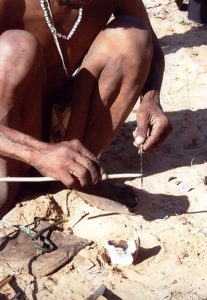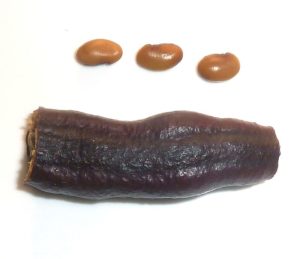The bow and arrow have been crucial tools for hunting throughout the latter part of human history. After the advent of these instruments, early hunters would have quickly realized that adding poisons to their tool kit would vastly improve hunting success. For many people, the use of poisons in hunting quickly conjures images of poison dart frogs from the rain forests of Central and South America. But a continent away, in the Kalahari Desert of southern Africa, a recent study looked at how the San use poisons from beetles and plants for their arrows. In fact, the San are one of the last remaining cultures still using such traditional methods.

The study was led by entomologist and beetle expert, Caroline Chaboo. Chaboo and her colleagues collected historical, anthropological, botanical, and entomological literature on this San practice. Their comprehensive study would finally synthesize a body of information that was incomplete as the result of vague documentation on the San and a lack of identifiable species used for poisons.
“The more slender threads of information I wove together from reports dating to the 1700’s, the more obvious it became there were few sure facts and many hard-to-believe assertions,” Chaboo explained to the Heritage Daily in a report earlier this year. “The San are traditional hunter-gatherers and thus have a special place in the history of man. As I learned more about the modern San, their history, weak political status and endangered languages and cultures, it became urgent to me to document this aspect of their culture.”
San tribes used, and some still use, arrows laced with the poisons of local beetles and plants allowing researchers to interview former hunters, and also see first-hand what species are collected and how the poisons are extracted. While the use of beetle poison was examined for a number of different San groups, the two largest were the focus of this study, the Ju|’hoan in northeast Namibia and the Hai||om at Etosha National Park, Namibia.
The San are a diverse group of people estimated around at 113,000 individuals, and ranging over six African countries: Angola, Botswana, Namibia, South Africa, Zambia, and Zimbabwe. They are widely known for their almost mythical hunting and tracking skills, the latter of which are important when following game shot with poison arrows. In fact, larger game such as antelope, buffalo, elephant, giraffe, lion, wildebeest, and zebra are often hunted with poison arrows while smaller game is trapped or snared.

“The poison is a slow-acting paralyzing poison,”Chaboo told the Heritage Daily. “The animal continues to run after being hit, but over the next few hours, the animal becomes increasingly unable to move well, and finally falls over. Then the hunter can finish off the animal. Cell breakdown and interference with cell membrane channels are implicated.”
The primary poison, identified as a protein called diamphotoxin, may be sequestered from the host plant or made outright by the insect. This toxin is derived from Diamphidia beetles, and apparently the ‘pupa’ stage has the highest concentration of poison. However, the study does point out that both Diamphidia and Polyclada beetles are used by different San groups.

A number of hunters demonstrated to the researchers how they extracted poison beetle larvae from around host plants using sticks. In some cases they dug a moat around the entire plant. Unlike the Hai||om, Ju|’hoan hunters were able to demonstrate preparation of the poison arrows since they still have the right to hunt on their lands.
To prepare the poison, a hunter first arranges his tools in the sand, which may include an old giraffe or kudu knuckle bone. Then, the hunter breaks open around ten cocoons and rolls the larvae between his fingers to break up the internal tissues. He extracts the tissue, placing it in a mortar made of bone. Next, he proceeds to chew the bark of Acacia mellifera to produce saliva which is mixed with the larval tissues. A bean of the Bobgunnia madagascariensis is then heated, cooled, and added to the tissue and saliva mixture. The addition of these plants provides increased toxicity to the beetle-derived poison. Hunters are careful when handling the poisons since they are also lethal for humans.
Once applied to the arrows, the poisons have a shelf life from several months to over a year, depending on the beetle species. Because of the limited availability of larvae and the shelf life of the poisons, use of poison arrows is seasonal.
For the research team it was important to be systematic in gathering both ethnographic data as well as a healthy number of specimens to create a clear picture of past and present use. In addition to interviewing hunters and following some to collect specimens, the research team caught live beetles at night and collected over 500 cocoons to determine beetle species and their life stages.

The evolutionary, cultural, and ecological significance of arrow poisons are important, but there are also potential medical uses. Like ethnobotanicals, newly discovered entomological chemicals could potentially be used to create drugs for human use.
Chaboo points out another reason this type of study is needed. “It’s remarkable that there is so much we still don’t know about life on Earth and even about the intricate relationships humans have with the environment,” she told the Heritage Daily. “Indigenous knowledge – accumulated over long periods of observations and experiences – holds deep insight about nature. Such knowledge can improve the quality of science and other fields and may offer resolutions to some pressing problems.”
Chaboo CS, Biesele M, Hitchcock RK, & Weeks A. 2016. Beetle and plant arrow poisons of the Ju|’hoan and Hai||om San peoples of Namibia (Insecta, Coleoptera, Chrysomelidae; Plantae, Anacardiaceae, Apocynaceae, Burseraceae). ZooKeys 558: 9-54.
By Sherrie Alexander, University of Alabama at Birmingham